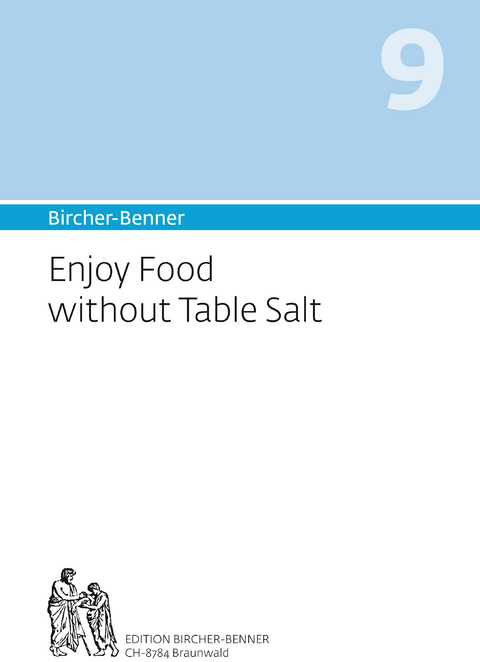
Bircher-Benner 9 Enjoy Food without Table Salt
Bircher-Benner (Verlag)
978-3-906089-33-1 (ISBN)
Dr. med. Andres Bircher grandson of Dr.med. Maximilian Bircher-Benner. Medical studies in Zürich and Geneva, ten years practice as a hospital physician in anaesthesiology, intensive care, emergency medicine, surgery, paediatrics, psychosomatics, haematology, geriatrics, psychiatry and psychotherapy, medical specialist(Facharzt) in an administrative position at Zürich university hospitals, teaching analysis with Brian Kenny, chief physician (Chefarzt) of a hospital for internal medicine in Zurich and later in Western Switzerland, medical specialist (Facharzt) in TCM and acupuncturist in Vienna; studies of neural therapy, manual therapy and traditional homeopathy, successful completion of medical specialist (Facharzt) training in balneology, climatology and physical medicine in Germany, scientific work on food energies, dietetics and the effects of regulatory medicine. Dr. med. Andres Bircher is the medical manager of the Centre for Scientific Natural Medicine Bircher-Benner.
Table of Contents
Preface . . . . . . . . . . . . . . . . . . . . . . . . . . . . . . . . . . . . . . . . . . . ……………………5
Blood Pressure Regulation in the Kidney . . . . . . . . . . . . . . . . . . . . . . . ………..…8
The Renin-Angiotensin-Aldosterone System of Blood Pressure Regulation . . .....8
Salt-Sensitive Hypertension . . . . . . . . . . . . . . . . . . . . . . . . . . . . . . . ……………..10
Osmotic Storage of Salt in Tissues . . . . . . . . . . . . . . . . . . . . . . . . . ………….…..10
Effect of Salt Storage on Blood Vessels and Blood Pressure . . . . . . . . . . . ....….10
Effect of a Low-Salt Diet on Blood Pressure . . . . . . . . . . . . . . . . . . ……..….…... 11
Epigenetic Inheritance of Salt Sensitivity . . . . . . . . . . . . . . . . . . . . . ……....……..11
Effect of Table Salt Storage on the Blood Vessels . . . . . . . . . . . . . . . . . ....……...11
Effects of Salinisation and Saccharisation (Glycation) of the Inner Layer
of the Blood Vessels . . . . . . . . . . . . . . . . . . . . . . . . . . . . . . . . . …………………..12
Oxidative Stress at the Centre of the Causes of Degenerative Diseases
and Dementia . . . . . . . . . . . . . . . . . . . . . . . . . . . . . . . . . . . . . . . ……….………...14
The Problem of Food Energy . . . . . . . . . . . . . . . . . . . . . . . . . . . . . …….……….. 17
Order Therapy for Hypertension . . . . . . . . . . . . . . . . . . . . . . . . . . ... …………….18
Photon Storage in Living Tissues . . . . . . . . . . . . . . . . . . . . . . . . . . ………………18
The Basic Regulation System of the Soft Connective Tissue . . . . . . . . ..... . . …..19
The Meaning of Food Economy . . . . . . . . . . . . . . . . . . . . . . . . . . . …....………….20
The Integral Law of Nutrition . . . . . . . . . . . . . . . . . . . . . . . . . . . . …..……………..22
Vibrancy of Food . . . . . . . . . . . . . . . . . . . . . . . . . . . . . . . . . . . ………..…………...22
Principles of the Bircher-Benner Diet and Order Therapy . . . . . . . . . ...... . . . . ….23
Order of Life and Physical Exercise . . . . . . . . . . . . . . . . . . . . . . . . . . . …..……….25
Menus for the Low-Salt Diet, for Patients with Hypertension and
Heart Problems…………………………………………………………………………. .26
Menu for 1 Week of Salt-free Diet (Milder Form) . . . . . . . . . . . . . . . . . ……....…...27
4 5
Recipes for Salt-free and Low-salt Food . . . . . . . . . . . . . . . . .... . . . . . . . ………...29
Juices . . . . . . . . . . . . . . . . . . . . . . . . . . . . . . . . . . . . . . . . . . ………………………..29
Gruel Added to Juices . . . . . . . . . . . . . . . . . . . . . . . . . . . . . . . .... ………………….30
Bircher Muesli . . . . . . . . . . . . . . . . . . . . . . . . . . . . . . . . . . . . ……………………….30
Raw Vegetables and Salads . . . . . . . . . . . . . . . . . . . . . . . . . . . . . ....………………32
Salad Dressings . . . . . . . . . . . . . . . . . . . . . . . . . . . . . . . . . . . . ……………………..33
Suggestions for Dressings to go with Salads and Raw Vegetables . . . . . ........ . . ..36
Milk Types . . . . . . . . . . . . . . . . . . . . . . . . . . . . . . . . . . . . . . . ………………………..37
Butter, Vegetable Fats and Oils . . . . . . . . . . . . . . . . . . . . . . . . . . . ………………....38
Gentle Cooking and Steaming . . . . . . . . . . . . . . . . . . . . . . . . . . . ..... ………………39
Soups . . . . . . . . . . . . . . . . . . . . . . . . . . . . . . . . . . . . . . . . . . ………………………...39
Soup Additions . . . . . . . . . . . . . . . . . . . . . . . . . . . . . . . . . . . . …………………….…40
Vegetables . . . . . . . . . . . . . . . . . . . . . . . . . . . . . . . . . . . . . . . …………………….…43
Salads of Cooked Vegetables . . . . . . . . . . . . . . . . . . . . . . . . . . . . ……………….....50
Potato Dishes . . . . . . . . . . . . . . . . . . . . . . . . . . . . . . . . . . . . . ……………………….51
Grain Dishes . . . . . . . . . . . . . . . . . . . . . . . . . . . . . . . . . . . . . ………………………...54
Sauces . . . . . . . . . . . . . . . . . . . . . . . . . . . . . . . . . . . . . . . . . …………………………58
Sandwiches . . . . . . . . . . . . . . . . . . . . . . . . . . . . . . . . . . . . . . ………………………...61
Desserts . . . . . . . . . . . . . . . . . . . . . . . . . . . . . . . . . . . . . . . . ………………………….62
Healthy Teas . . . . . . . . . . . . . . . . . . . . . . . . . . . . . . . . . . . . . . ………………………..67
Table Regarding Glycaemic Index and Glycaemic Charge . . . . . . . . . . . . . . ............69
List of Recipes . . . . . . . . . . . . . . . . . . . . . . . . . . . . . . . . . . . . . . . ……………….……73
Notes . . . . . . . . . . . . . . . . . . . . . . . . . . . . . . . . . . . . . . . . . . . . ………………….…….77
Index . . . . . . . . . . . . . . . . . . . . . . . . . . . . . . . . . . . . . . . . . . . . …………………..…….80
Preface Table salt has always been one of the most popular stimulants. In the CelticGermanic region, the production of sea salt was on a large scale as early as the Bronze Age1. The Sumerians preserved their food with salt. Pliny the Elder and Lucius Columella estimated that daily salt consumption in ancient Rome corresponded to 25 g/person. Through the 19th century, table salt was used mainly as a preservative for meat, cabbage and beans2. Yet few people are aware of the damage caused by excessive amounts of table salt. In the 1970s, high salt consumption was recognised as a major cause of hypertension, and consequently a significant source of cardiovascular disease. The Food and Drug Administration has estimated consumption of table salt in the US at 8.4 g/person, which corresponds to about 2¼ teaspoons per day. US authorities have issued guidelines to reduce table salt in all convenience foods, as they account for 75% of salt consumption. They estimate that a 40% reduction could save 500,000 lives in the course of the next decade. The daily human salt demand depends on the climate and season. Today it is estimated to be in the range of 1.8–6.4 g per day. The World Health Organisation currently recommends 5 g per day, or about 1.2 level teaspoons. Many people underestimate their salt consumption, as three-quarters of it comes from convenience foods and only about one-quarter from salting. Cured convenience foods such as fish, meat and sausage products are popular. Pickling salt is table salt with the addition of 0.4–0.5% sodium nitrite. Nitrite combines the radical nitric oxide (NO) with myoglobin into heat-stable nitroso-myoglobin, which gives cured meat a more appetising, stable red colour. As a result, all products cured with nitrite are carcinogenic. There is also the sodium content from sodium fluoride. Since 2006, sodium fluoride has been added to table salt throughout the EU to prevent tooth decay. Eighty percent of the population uses sodium fluoride. The addition of spices and other flavourings, such as glutamate, leads to the extensive range of seasoning salts. Spices are supposed to flavour the salt, while salt has a stabilising effect on the spices. The processes that lead to hypertension are complex. Some influences are genetic and environmental, though it is not clear why people are not equally sensitive to high levels of table salt. In about 70% of the population, even a relatively small overdose of table salt causes hypertension (“salt-sensitive hypertension”). Others have a higher toleration for table salt, even storing excessive salt in their body tissues. However, high salt concentrations also have pathogenic effects on the vascular system, independent of blood pressure in people in whom the high salt concentrations do not immediately produce hypertension. An excessive amount of table salt damages the inner layer of the blood vessels and the endothelium, and also causes arteriosclerosis. The concealed consumption of salt in industrial convenience products and fast food has increased drastically. At the same time, we see a massive increase in hypertension. Thirty percent of the world’s population suffers from hypertension today. More than half of all adults over the age of 19 in industrialised countries suffer from hypertension and take antihypertensive medication. Given such statistics, the “average adult” has hypertension. It is no longer “the norm” not to have hypertension and not to have to take antihypertensive medication. Table salt is not the only thing that causes hypertension. The high consumption of white flour products and sugar also damages the inner layer of the vessels through direct chemical reaction of the sugars with the endothelium. This innermost layer regulates the anatomical structure and muscle tension throughout the vascular wall. The damage caused by this excess of table salt and sugar destroys the endothelium’s ability to regulate the muscle tension of the blood vessels and their structure and fibre content. This is referred to as endothelial dysfunction. The vessels narrow and can no longer be widened when blood flow increases, initially increasing blood pressure at exertion or excitement (labile hypertension). Then the vessel walls harden due to the storage of hard connective tissue (collagen). This causes constantly elevated blood pressure, even during relaxation and sleep (fixed hypertension). Metabolic waste products then become increasingly deposited in the intercellular substance (matrix) of the vessel walls. This leads to inflammation and thickening the vessel walls into arteriosclerotic plaques, until they begin to store cholesterol and calcium. High consumption of salt, white flour and sugar thereby produces arteriosclerosis at a young age. Angina pectoris and myocardial infarction develop if this occurs in the coronary arteries; in the carotid arteries that supply the brain, it leads to cerebral apoplexy. In arteries of the legs, intermittent claudication (claudication intermittens) leads to cramps and pain when walking, since the leg arteries are narrowed by arteriosclerosis and can no longer supply the blood and oxygen needed. High consumption of salt, white flour and sugar will damage the fine vessels of the kidneys and the eyes, and prevents the aqueous humour of the eyes from draining through the fine structures in the corner of the eye, which in turn increases pressure in the eyes. This leads to glaucoma, blindness due to glaucoma, and macular degeneration. All of these tragic diseases seem to be a tragic fate. In fact, they have nothing to do with “fate”, since they can be reliably prevented by following a diet of living vegetarian whole foods with a high proportion of raw vegetables seasoned with fresh herbs, while avoiding all irritants such as excessive amounts of table salt, sugar, coffee and alcohol. While these diseases cannot be prevented by any drug, they can be prevented by a diet and lifestyle that meet our biological needs. A low-salt diet is necessary if hypertension has already developed or if cardiovascular disease has progressed. The recipes given in this book were developed in the famous Bircher-Benner Clinic. Creating low-salt and salt-free recipes that are not bland but delicious is a fine art. This manual is based on vast experience in the treatment of people suffering from nutrition-related diseases. Since Dr. med. Maximilian Bircher-Benner discovered the immense healing effect of a strict, fresh, plant-based diet and an orderly lifestyle more than a century ago, the Bircher-Benner Clinic, today called the Bircher-Benner Medical Centre, has healed thousands of people suffering from the “diseases of civilisation” that today are spreading massively. This manual describes one of the building blocks for therapy that does not merely suppress symptoms, but tackles the root causes of disease in order to cure it. The recipes can be used in practice. For the physician, this book is a great time saver in counselling patients. Braunwald, February 2022 Dr. med. Andres Bircher
Preface Table salt has always been one of the most popular stimulants. In the CelticGermanic region, the production of sea salt was on a large scale as early as the Bronze Age1. The Sumerians preserved their food with salt. Pliny the Elder and Lucius Columella estimated that daily salt consumption in ancient Rome corresponded to 25 g/person. Through the 19th century, table salt was used mainly as a preservative for meat, cabbage and beans2. Yet few people are aware of the damage caused by excessive amounts of table salt. In the 1970s, high salt consumption was recognised as a major cause of hypertension, and consequently a significant source of cardiovascular disease. The Food and Drug Administration has estimated consumption of table salt in the US at 8.4 g/person, which corresponds to about 2¼ teaspoons per day. US authorities have issued guidelines to reduce table salt in all convenience foods, as they account for 75% of salt consumption. They estimate that a 40% reduction could save 500,000 lives in the course of the next decade. The daily human salt demand depends on the climate and season. Today it is estimated to be in the range of 1.8-6.4 g per day. The World Health Organisation currently recommends 5 g per day, or about 1.2 level teaspoons. Many people underestimate their salt consumption, as three-quarters of it comes from convenience foods and only about one-quarter from salting. Cured convenience foods such as fish, meat and sausage products are popular. Pickling salt is table salt with the addition of 0.4-0.5% sodium nitrite. Nitrite combines the radical nitric oxide (NO) with myoglobin into heat-stable nitroso-myoglobin, which gives cured meat a more appetising, stable red colour. As a result, all products cured with nitrite are carcinogenic. There is also the sodium content from sodium fluoride. Since 2006, sodium fluoride has been added to table salt throughout the EU to prevent tooth decay. Eighty percent of the population uses sodium fluoride. The addition of spices and other flavourings, such as glutamate, leads to the extensive range of seasoning salts. Spices are supposed to flavour the salt, while salt has a stabilising effect on the spices. The processes that lead to hypertension are complex. Some influences are genetic and environmental, though it is not clear why people are not equally sensitive to high levels of table salt. In about 70% of the population, even a relatively small overdose of table salt causes hypertension ("salt-sensitive hypertension"). Others have a higher toleration for table salt, even storing excessive salt in their body tissues. However, high salt concentrations also have pathogenic effects on the vascular system, independent of blood pressure in people in whom the high salt concentrations do not immediately produce hypertension. An excessive amount of table salt damages the inner layer of the blood vessels and the endothelium, and also causes arteriosclerosis. The concealed consumption of salt in industrial convenience products and fast food has increased drastically. At the same time, we see a massive increase in hypertension. Thirty percent of the world's population suffers from hypertension today. More than half of all adults over the age of 19 in industrialised countries suffer from hypertension and take antihypertensive medication. Given such statistics, the "average adult" has hypertension. It is no longer "the norm" not to have hypertension and not to have to take antihypertensive medication. Table salt is not the only thing that causes hypertension. The high consumption of white flour products and sugar also damages the inner layer of the vessels through direct chemical reaction of the sugars with the endothelium. This innermost layer regulates the anatomical structure and muscle tension throughout the vascular wall. The damage caused by this excess of table salt and sugar destroys the endothelium's ability to regulate the muscle tension of the blood vessels and their
| Erscheinungsdatum | 25.05.2022 |
|---|---|
| Verlagsort | Braunwald |
| Sprache | englisch |
| Maße | 150 x 210 mm |
| Gewicht | 200 g |
| Themenwelt | Medizin / Pharmazie ► Naturheilkunde |
| Medizin / Pharmazie ► Studium | |
| Schlagworte | Bircher • Bircher-Benner • Bircher-Benner 9 • Blood pressure • Cause of heart attack • Cure for salt-sensitive hypertension • Diseases caused by too much salt • Eating without salt • Effect of low-salt diet on blood pressure • Effect of salinisation and saccharification of the inner layer of the blood vessels • Effect of salt storage on blood vessels and tissues • Enjoy Food without Table salt • Glycaemic index • Glycaemic load • Hypertension • Low-salt diet • Low-salt diet diet • Low-sodium diet • Order therapy of hypertension • Osmotic accumulation of salt in tissues • Recipes for saltless and low-salt diets • Salt-sensitive hypertension |
| ISBN-10 | 3-906089-33-9 / 3906089339 |
| ISBN-13 | 978-3-906089-33-1 / 9783906089331 |
| Zustand | Neuware |
| Haben Sie eine Frage zum Produkt? |
aus dem Bereich


